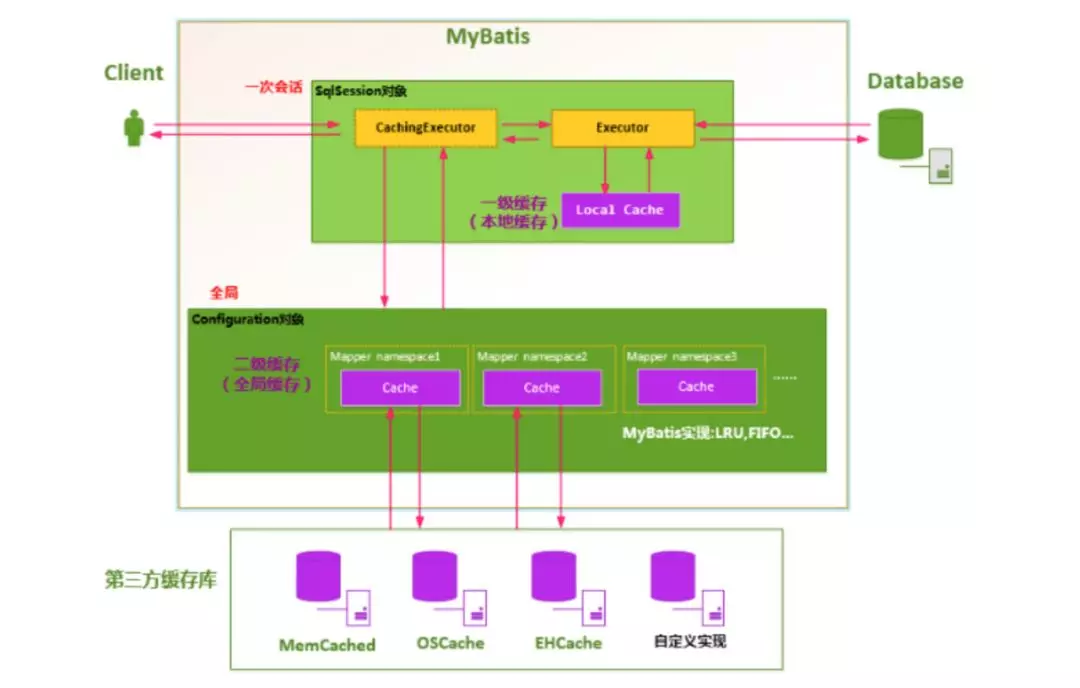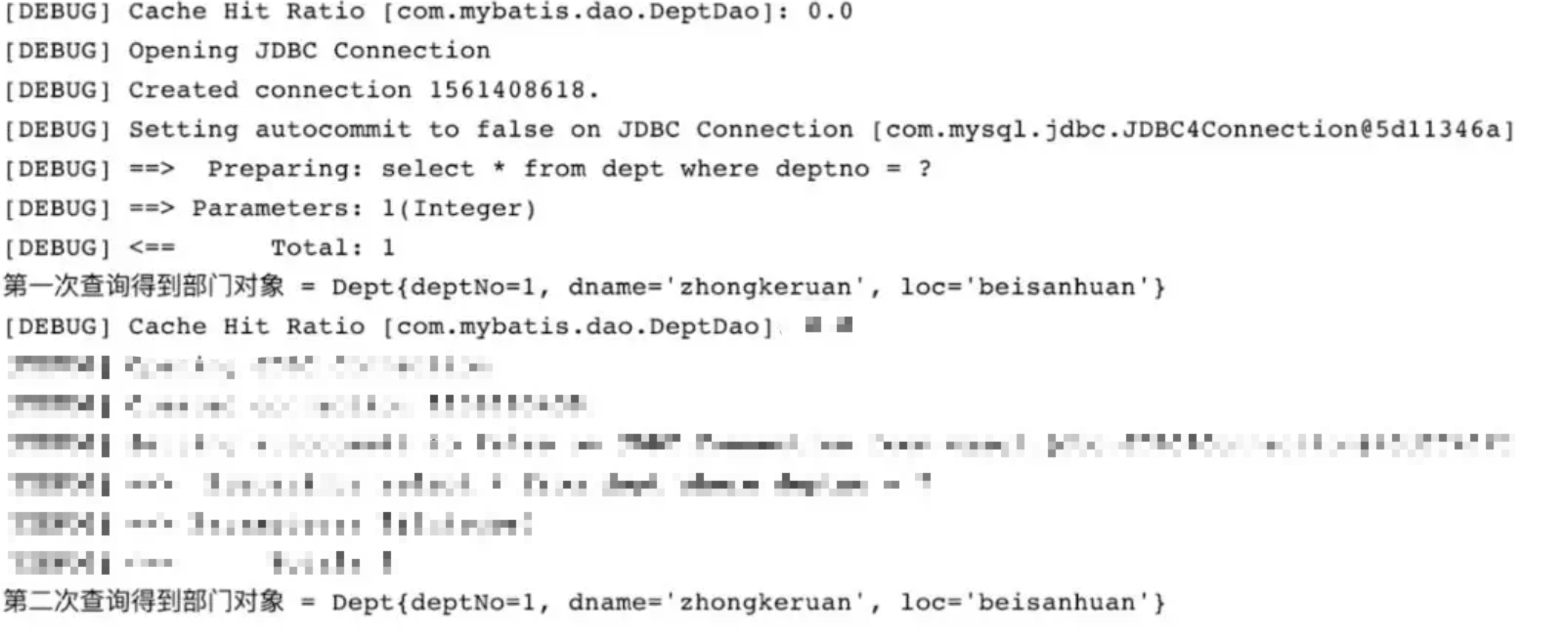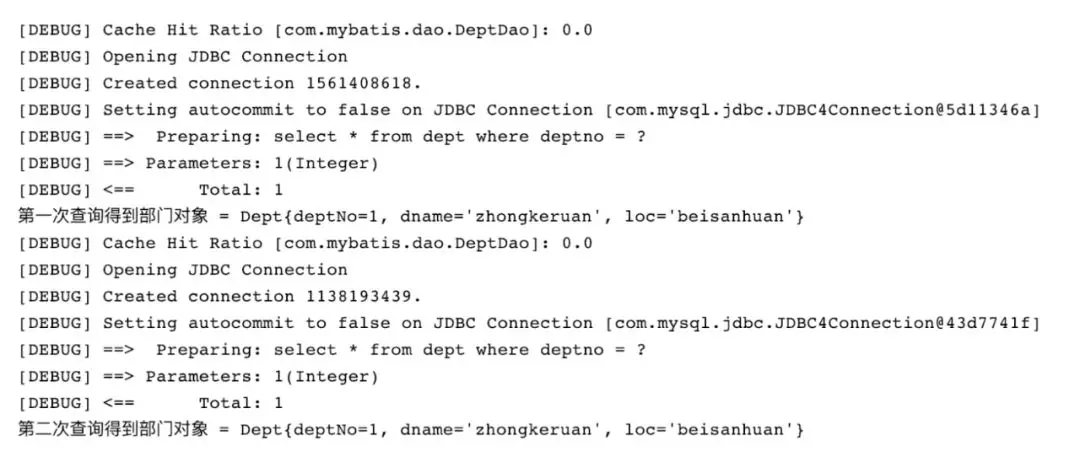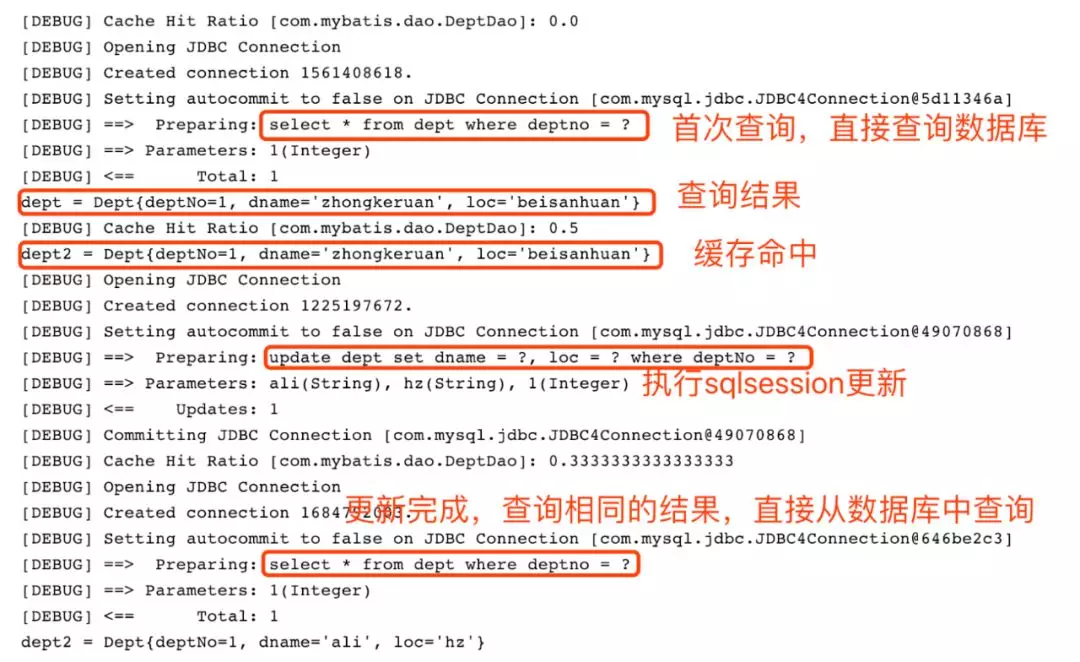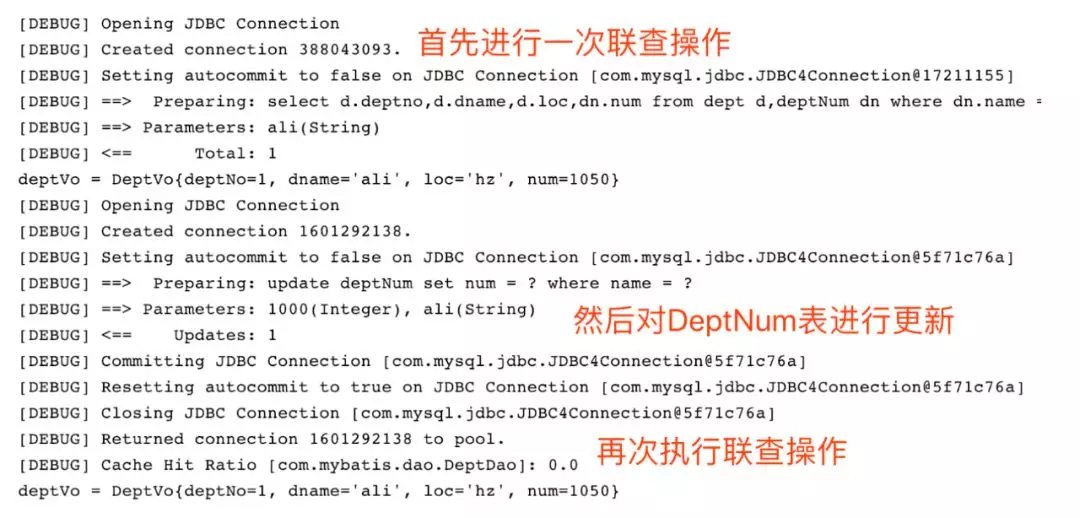摘要
MyBatis 二级缓存介绍
上一篇文章中我们介绍到了 MyBatis 一级缓存其实就是 SqlSession 级别的缓存,什么是 SqlSession 级别的缓存呢?一级缓存的本质是什么呢?以及一级缓存失效的原因?我希望你在看下文之前能够回想起来这些内容。
MyBatis 一级缓存最大的共享范围就是一个SqlSession内部,那么如果多个 SqlSession 需要共享缓存,则需要开启二级缓存,开启二级缓存后,会使用 CachingExecutor 装饰 Executor,进入一级缓存的查询流程前,先在CachingExecutor 进行二级缓存的查询,具体的工作流程如下所示
当二级缓存开启后,同一个命名空间(namespace) 所有的操作语句,都影响着一个 共同的 cache,也就是二级缓存被多个 SqlSession 共享,是一个全局的变量。当开启缓存后,数据的查询执行的流程就是 二级缓存 -> 一级缓存 -> 数据库。
二级缓存开启条件
二级缓存默认是不开启的,需要手动开启二级缓存,实现二级缓存的时候,MyBatis要求返回的POJO必须是可序列化的。开启二级缓存的条件也是比较简单,通过直接在 MyBatis 配置文件中通过
1 <settings > <setting name = "cacheEnabled" value = "true" /> </settings >
来开启二级缓存,还需要在 Mapper 的xml 配置文件中加入 标签
设置 cache 标签的属性
cache 标签有多个属性,一起来看一些这些属性分别代表什么意义
eviction: 缓存回收策略,有这几种回收策略
LRU - 最近最少回收,移除最长时间不被使用的对象
FIFO - 先进先出,按照缓存进入的顺序来移除它们
SOFT - 软引用,移除基于垃圾回收器状态和软引用规则的对象
WEAK - 弱引用,更积极的移除基于垃圾收集器和弱引用规则的对象
默认是 LRU 最近最少回收策略
flushinterval 缓存刷新间隔,缓存多长时间刷新一次,默认不清空,设置一个毫秒值
readOnly: 是否只读;true 只读 ,MyBatis 认为所有从缓存中获取数据的操作都是只读操作,不会修改数据。MyBatis 为了加快获取数据,直接就会将数据在缓存中的引用交给用户。不安全,速度快。读写(默认) :MyBatis 觉得数据可能会被修改
size : 缓存存放多少个元素
type: 指定自定义缓存的全类名(实现Cache 接口即可)
blocking:若缓存中找不到对应的key,是否会一直blocking,直到有对应的数据进入缓存。
探究二级缓存
我们继续以 MyBatis 一级缓存文章中的例子为基础,搭建一个满足二级缓存的例子,来对二级缓存进行探究,例子如下(对 一级缓存的例子部分源码进行修改):
Dept.java
//存放在共享缓存中数据进行序列化操作和反序列化操作
//因此数据对应实体类必须实现【序列化接口】并提供 无参数的构造方法
1 public class Dept implements Serializable
myBatis-config.xml
在myBatis-config 中添加开启二级缓存的条件
1 <setting name ="cacheEnabled" value ="true" />
DeptDao.xml
还需要在 Mapper 对应的xml中添加 cache 标签,表示对哪个mapper 开启缓存
对应的二级缓存测试类如下:
1 2 3 4 5 6 7 8 9 10 11 12 13 14 15 16 17 18 19 20 21 22 23 24 25 26 27 28 29 30 31 32 33 34 35 36 public class MyBatisSecondCacheTest private SqlSession sqlSession; SqlSessionFactory factory; @Before public void start () throws IOException InputStream is = Resources.getResourceAsStream("myBatis-config.xml" ); SqlSessionFactoryBuilder builderObj = new SqlSessionFactoryBuilder(); factory = builderObj.build(is); sqlSession = factory.openSession(); } @After public void destory () if (sqlSession!=null ){ sqlSession.close(); } } @Test public void testSecondCache () DeptDao dao = sqlSession.getMapper(DeptDao.class ) ; Dept dept = dao.findByDeptNo(1 ); System.out.println("第一次查询得到部门对象 = " +dept); sqlSession.commit(); SqlSession session2 = factory.openSession(); DeptDao dao2 = session2.getMapper(DeptDao.class ) ; Dept dept2 = dao2.findByDeptNo(1 ); System.out.println("第二次查询得到部门对象 = " +dept2); } }
测试二级缓存效果,提交事务,sqlSession 查询完数据后,sqlSession2相同的查询是否会从缓存中获取数据。
测试结果如下:
通过结果可以得知,首次执行的SQL语句是从数据库中查询得到的结果,然后第一个 SqlSession 执行提交,第二个 SqlSession 执行相同的查询后是从缓存中查取的。
用一下这幅图能够比较直观的反映两次 SqlSession 的缓存命中
二级缓存失效的条件
与一级缓存一样,二级缓存也会存在失效的条件的,下面我们就来探究一下哪些情况会造成二级缓存失效
第一次SqlSession 未提交
SqlSession 在未提交的时候,SQL 语句产生的查询结果还没有放入二级缓存中,这个时候 SqlSession2 在查询的时候是感受不到二级缓存的存在的,修改对应的测试类,结果如下:
1 2 3 4 5 6 7 8 9 10 11 12 13 14 @Test public void testSqlSessionUnCommit () DeptDao dao = sqlSession.getMapper(DeptDao.class ) ; Dept dept = dao.findByDeptNo(1 ); System.out.println("第一次查询得到部门对象 = " +dept); SqlSession session2 = factory.openSession(); DeptDao dao2 = session2.getMapper(DeptDao.class ) ; Dept dept2 = dao2.findByDeptNo(1 ); System.out.println("第二次查询得到部门对象 = " +dept2); }
产生的输出结果:
更新对二级缓存影响
与一级缓存一样,更新操作很可能对二级缓存造成影响,下面用三个 SqlSession来进行模拟,第一个 SqlSession 只是单纯的提交,第二个 SqlSession 用于检验二级缓存所产生的影响,第三个 SqlSession 用于执行更新操作,测试如下:
1 2 3 4 5 6 7 8 9 10 11 12 13 14 15 16 17 18 19 20 21 22 23 24 25 26 @Test public void testSqlSessionUpdate () SqlSession sqlSession = factory.openSession(); SqlSession sqlSession2 = factory.openSession(); SqlSession sqlSession3 = factory.openSession(); DeptDao deptDao = sqlSession.getMapper(DeptDao.class ) ; Dept dept = deptDao.findByDeptNo(1 ); System.out.println("dept = " + dept); sqlSession.commit(); DeptDao deptDao2 = sqlSession2.getMapper(DeptDao.class ) ; Dept dept2 = deptDao2.findByDeptNo(1 ); System.out.println("dept2 = " + dept2); DeptDao deptDao3 = sqlSession3.getMapper(DeptDao.class ) ; deptDao3.updateDept(new Dept(1 ,"ali" ,"hz" )); sqlSession3.commit(); dept2 = deptDao2.findByDeptNo(1 ); System.out.println("dept2 = " + dept2); }
对应的输出结果如下
探究多表操作对二级缓存的影响
现有这样一个场景,有两个表,部门表dept(deptNo,dname,loc)和 部门数量表deptNum(id,name,num),其中部门表的名称和部门数量表的名称相同,通过名称能够联查两个表可以知道其坐标(loc)和数量(num),现在我要对部门数量表的 num 进行更新,然后我再次关联dept 和 deptNum 进行查询,你认为这个 SQL 语句能够查询到的 num 的数量是多少?来看一下代码探究一下
1 2 3 4 5 6 7 8 public class DeptNum private int id; private String name; private int num; get and set... }
1 2 3 4 5 6 7 8 9 10 11 12 13 14 15 16 17 18 19 20 21 22 public class DeptVo private Integer deptNo; private String dname; private String loc; private Integer num; public DeptVo (Integer deptNo, String dname, String loc, Integer num) this .deptNo = deptNo; this .dname = dname; this .loc = loc; this .num = num; } public DeptVo (String dname, Integer num) this .dname = dname; this .num = num; } get and set... toString()... }
1 2 3 4 5 6 7 8 9 public interface DeptDao DeptVo selectByDeptVo (String name) ; DeptVo selectByDeptVoName (String name) ; int updateDeptVoNum (DeptVo deptVo) }
1 2 3 4 5 6 7 8 9 10 11 12 <select id ="selectByDeptVo" resultType ="com.mybatis.beans.DeptVo" > select d.deptno,d.dname,d.loc,dn.num from dept d,deptNum dn where dn.name = d.dname and d.dname = #{name} </select > <select id ="selectByDeptVoName" resultType ="com.mybatis.beans.DeptVo" > select * from deptNum where name = #{name} </select > <update id ="updateDeptVoNum" parameterType ="com.mybatis.beans.DeptVo" > update deptNum set num = #{num} where name = #{dname} </update >
DeptNum 数据库初始值:
1 2 3 4 5 6 7 8 9 10 11 12 13 14 15 16 17 18 19 20 21 @Test public void testOtherMapper () SqlSession sqlSession = factory.openSession(); DeptDao deptDao = sqlSession.getMapper(DeptDao.class ) ; DeptVo deptVo = deptDao.selectByDeptVo("ali" ); System.out.println("deptVo = " + deptVo); SqlSession sqlSession2 = factory.openSession(); DeptDao deptDao2 = sqlSession2.getMapper(DeptDao.class ) ; deptDao2.updateDeptVoNum(new DeptVo("ali" ,1000 )); sqlSession2.commit(); sqlSession2.close(); deptVo = deptDao.selectByDeptVo("ali" ); System.out.println("deptVo = " + deptVo); }
测试结果如下:
在对DeptNum 表执行了一次更新后,再次进行联查,发现数据库中查询出的还是 num 为 1050 的值,也就是说,实际上 1050 -> 1000 ,最后一次联查实际上查询的是第一次查询结果的缓存,而不是从数据库中查询得到的值,这样就读到了脏数据。
解决办法
如果是两个mapper命名空间的话,可以使用<cache-ref>来把一个命名空间指向另外一个命名空间,从而消除上述的影响,再次执行,就可以查询到正确的数据
二级缓存源码解析
源码模块主要分为两个部分:二级缓存的创建和二级缓存的使用,首先先对二级缓存的创建进行分析:
二级缓存的创建
二级缓存的创建是使用 Resource 读取 XML 配置文件开始的
1 2 3 InputStream is = Resources.getResourceAsStream("myBatis-config.xml" ); SqlSessionFactoryBuilder builder = new SqlSessionFactoryBuilder(); factory = builder.build(is);
读取配置文件后,需要对XML创建 Configuration并初始化
1 2 XMLConfigBuilder parser = new XMLConfigBuilder(inputStream, environment, properties); return build(parser.parse());
调用 parser.parse() 解析根目录 /configuration 下面的标签,依次进行解析
1 2 3 4 5 6 7 8 public Configuration parse () if (parsed) { throw new BuilderException("Each XMLConfigBuilder can only be used once." ); } parsed = true ; parseConfiguration(parser.evalNode("/configuration" )); return configuration; }
1 2 3 4 5 6 7 8 9 10 11 12 13 14 15 16 17 18 19 20 21 private void parseConfiguration (XNode root) try { propertiesElement(root.evalNode("properties" )); Properties settings = settingsAsProperties(root.evalNode("settings" )); loadCustomVfs(settings); typeAliasesElement(root.evalNode("typeAliases" )); pluginElement(root.evalNode("plugins" )); objectFactoryElement(root.evalNode("objectFactory" )); objectWrapperFactoryElement(root.evalNode("objectWrapperFactory" )); reflectorFactoryElement(root.evalNode("reflectorFactory" )); settingsElement(settings); environmentsElement(root.evalNode("environments" )); databaseIdProviderElement(root.evalNode("databaseIdProvider" )); typeHandlerElement(root.evalNode("typeHandlers" )); mapperElement(root.evalNode("mappers" )); } catch (Exception e) { throw new BuilderException("Error parsing SQL Mapper Configuration. Cause: " + e, e); } }
其中有一个二级缓存的解析就是
1 mapperElement(root.evalNode("mappers" ));
然后进去 mapperElement 方法中
1 2 XMLMapperBuilder mapperParser = new XMLMapperBuilder(inputStream, configuration, resource, configuration.getSqlFragments()); mapperParser.parse();
继续跟 mapperParser.parse() 方法
1 2 3 4 5 6 7 8 9 10 11 public void parse () if (!configuration.isResourceLoaded(resource)) { configurationElement(parser.evalNode("/mapper" )); configuration.addLoadedResource(resource); bindMapperForNamespace(); } parsePendingResultMaps(); parsePendingCacheRefs(); parsePendingStatements(); }
这其中有一个 configurationElement 方法,它是对二级缓存进行创建,如下
1 2 3 4 5 6 7 8 9 10 11 12 13 14 15 16 17 private void configurationElement (XNode context) try { String namespace = context.getStringAttribute("namespace" ); if (namespace == null || namespace.equals("" )) { throw new BuilderException("Mapper's namespace cannot be empty" ); } builderAssistant.setCurrentNamespace(namespace); cacheRefElement(context.evalNode("cache-ref" )); cacheElement(context.evalNode("cache" )); parameterMapElement(context.evalNodes("/mapper/parameterMap" )); resultMapElements(context.evalNodes("/mapper/resultMap" )); sqlElement(context.evalNodes("/mapper/sql" )); buildStatementFromContext(context.evalNodes("select|insert|update|delete" )); } catch (Exception e) { throw new BuilderException("Error parsing Mapper XML. Cause: " + e, e); } }
有两个二级缓存的关键点
1 2 cacheRefElement(context.evalNode("cache-ref" )); cacheElement(context.evalNode("cache" ));
也就是说,mybatis 首先进行解析的是 cache-ref 标签,其次进行解析的是 cache 标签。
根据上面我们的 — 多表操作对二级缓存的影响 一节中提到的解决办法,采用 cache-ref 来进行命名空间的依赖能够避免二级缓存 ,但是总不能每次写一个 XML 配置都会采用这种方式吧,最有效的方式还是避免多表操作使用二级缓存
然后我们再来看一下cacheElement(context.evalNode(“cache”)) 这个方法
1 2 3 4 5 6 7 8 9 10 11 12 13 14 private void cacheElement (XNode context) throws Exception if (context != null ) { String type = context.getStringAttribute("type" , "PERPETUAL" ); Class<? extends Cache> typeClass = typeAliasRegistry.resolveAlias(type); String eviction = context.getStringAttribute("eviction" , "LRU" ); Class<? extends Cache> evictionClass = typeAliasRegistry.resolveAlias(eviction); Long flushInterval = context.getLongAttribute("flushInterval" ); Integer size = context.getIntAttribute("size" ); boolean readWrite = !context.getBooleanAttribute("readOnly" , false ); boolean blocking = context.getBooleanAttribute("blocking" , false ); Properties props = context.getChildrenAsProperties(); builderAssistant.useNewCache(typeClass, evictionClass, flushInterval, size, readWrite, blocking, props); } }
认真看一下其中的属性的解析,是不是感觉很熟悉?这不就是对 cache 标签属性的解析吗?!!!
上述最后一句代码
1 builderAssistant.useNewCache(typeClass, evictionClass, flushInterval, size, readWrite, blocking, props);
1 2 3 4 5 6 7 8 9 10 11 12 13 14 15 16 17 18 19 20 public Cache useNewCache (Class<? extends Cache> typeClass, Class<? extends Cache> evictionClass, Long flushInterval, Integer size, boolean readWrite, boolean blocking, Properties props) Cache cache = new CacheBuilder(currentNamespace) .implementation(valueOrDefault(typeClass, PerpetualCache.class )) .addDecorator (valueOrDefault (evictionClass , LruCache .class )) .clearInterval (flushInterval ) .size (size ) .readWrite (readWrite ) .blocking (blocking ) .properties (props ) .build () ; configuration.addCache(cache); currentCache = cache; return cache; }
这段代码使用了构建器模式,一步一步构建Cache 标签的所有属性,最终把 cache 返回。
二级缓存的使用
在 mybatis 中,使用 Cache 的地方在 CachingExecutor中,来看一下 CachingExecutor 中缓存做了什么工作,我们以查询为例
1 2 3 4 5 6 7 8 9 10 11 12 13 14 15 16 17 18 19 20 21 22 @Override public <E> List<E> query (MappedStatement ms, Object parameterObject, RowBounds rowBounds, ResultHandler resultHandler, CacheKey key, BoundSql boundSql) throws SQLException { Cache cache = ms.getCache(); if (cache != null ) { flushCacheIfRequired(ms); if (ms.isUseCache() && resultHandler == null ) { ensureNoOutParams(ms, parameterObject, boundSql); @SuppressWarnings ("unchecked" ) List<E> list = (List<E>) tcm.getObject(cache, key); if (list == null ) { list = delegate.<E> query(ms, parameterObject, rowBounds, resultHandler, key, boundSql); tcm.putObject(cache, key, list); } return list; } } return delegate.<E> query(ms, parameterObject, rowBounds, resultHandler, key, boundSql); }
其中,先从 MapperStatement 取出缓存。只有通过
如果缓存不为空,说明是存在缓存。如果cache存在,那么会根据sql配置(<insert>,<select>,<update>,<delete>的flushCache属性来确定是否清空缓存。
1 flushCacheIfRequired(ms);
然后根据xml配置的属性useCache来判断是否使用缓存(resultHandler一般使用的默认值,很少会null)。
1 if (ms.isUseCache() && resultHandler == null )
确保方法没有Out类型的参数,mybatis不支持存储过程的缓存,所以如果是存储过程,这里就会报错。
1 2 3 4 5 6 7 8 9 private void ensureNoOutParams (MappedStatement ms, Object parameter, BoundSql boundSql) if (ms.getStatementType() == StatementType.CALLABLE) { for (ParameterMapping parameterMapping : boundSql.getParameterMappings()) { if (parameterMapping.getMode() != ParameterMode.IN) { throw new ExecutorException("Caching stored procedures with OUT params is not supported. Please configure useCache=false in " + ms.getId() + " statement." ); } } } }
然后根据在 TransactionalCacheManager 中根据 key 取出缓存,如果没有缓存,就会执行查询,并且将查询结果放到缓存中并返回取出结果,否则就执行真正的查询方法。
1 2 3 4 5 6 List<E> list = (List<E>) tcm.getObject(cache, key); if (list == null ) { list = delegate.<E> query(ms, parameterObject, rowBounds, resultHandler, key, boundSql); tcm.putObject(cache, key, list); } return list;
是否应该使用二级缓存?
那么究竟应该不应该使用二级缓存呢?先来看一下二级缓存的注意事项:
缓存是以namespace为单位的,不同namespace下的操作互不影响。
insert,update,delete操作会清空所在namespace下的全部缓存。
通常使用MyBatis Generator生成的代码中,都是各个表独立的,每个表都有自己的namespace。
多表操作一定不要使用二级缓存,因为多表操作进行更新操作,一定会产生脏数据。
如果你遵守二级缓存的注意事项,那么你就可以使用二级缓存。
但是,如果不能使用多表操作,二级缓存不就可以用一级缓存来替换掉吗?而且二级缓存是表级缓存,开销大,没有一级缓存直接使用 HashMap 来存储的效率更高,所以二级缓存并不推荐使用 。
文章来源 .
